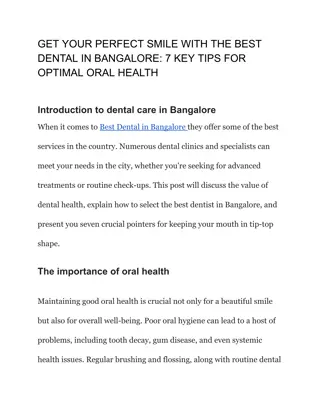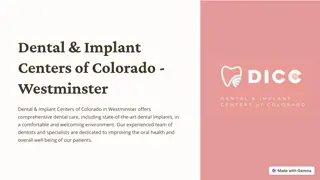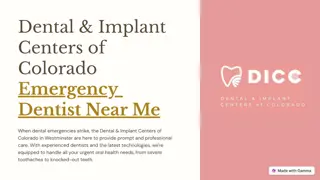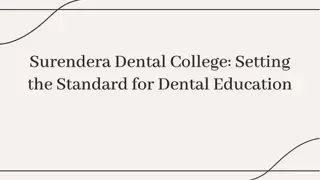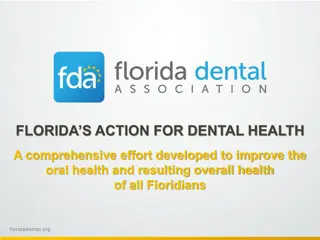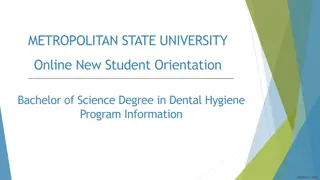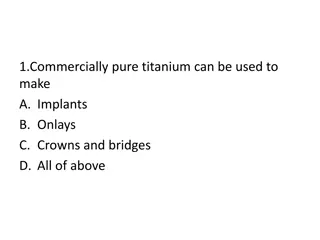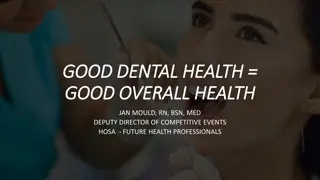Understanding Health Canada's Safety Regulations for Dental Allograft Use
Health Canada's Safety of Human Cells, Tissues, and Organs for Transplantation Regulations impact dentists using human allograft tissues in surgical procedures. Learn about compliance requirements, types of allograft tissues, and alternative graft options in dental practice.
Download Presentation

Please find below an Image/Link to download the presentation.
The content on the website is provided AS IS for your information and personal use only. It may not be sold, licensed, or shared on other websites without obtaining consent from the author. Download presentation by click this link. If you encounter any issues during the download, it is possible that the publisher has removed the file from their server.
E N D
Presentation Transcript
Compliance with Health Canada s Safety of Human Cells, Tissues, and Organs for Transplantation Regulations for Dentists
Introduction to Health Canadas CTO Regs In 2008, Health Canada s Safety of Human Cells, Tissues, and Organs for Transplantation Regulations (CTO Regs) came into force. These Regulations govern all aspects of the use of human allograft tissue products from processing to transplantation. Users of human allograft tissue products are required to meet the requirements of the Regulations.
What are human allograft tissue products? Human allograft tissue products are tissues that are recovered from medically suitable tissue donors. These tissues are then screened and processed using strict quality controls. Once deemed safe for transplant, these tissues are distributed to hospitals and dental practices for use in various surgical procedures. Human allograft tissues transplanted in Canada must be obtained from Health Canada registered source establishments.
Some examples of allograft tissues and their use in dental practice Product Procedure Demineralized bone Dental implant Socket preservation Maxillary/ mandibular defect repair Particulate bone grafts Cavitary defect repair Periprosthetic defect repair Acellular dermal matrix Dentoalveolar ridge defect repair Root coverage Mineralized bone; any other human derived bone product Dental implant Ridge defect repair
Are there other products used in dental practice? Yes. There are other options available aside from human derived tissue allograft products. Graft type Source of graft material Autograft Same individual who is receiving the graft Xenograft A different species such as a pig or a cow Alloplastic graft Synthetic material Canadian Dental Association. (2010). Guidance Document for Dentists Providing Human Allogenic Transplants. Ottawa, Ontario.
How do I know if I am using human allograft tissues in my practice? The package insert should clearly indicate that the product is a human allograft tissue product. AlloDerm Regenerative Tissue Matrix is donated allograft human dermis DBX is demineralized bone matrix that has osteoinductive potential and is osteoconductive. It is composed from demineralized bone from human donors
Do I need to register with Health Canada? As a dentist providing transplant services, you do not have to register with Health Canada provided you are importing human allograft tissues for use in your own practice only. If you are importing human allograft tissues and providing them to other dentists for use in other practices, you must register with Health Canada as an importer.
What else do I need to know? The next slides will cover: Exceptional distribution Record keeping Adverse reaction, error, and accident reporting
Exceptional distribution It is unlikely that you will ever encounter exceptionally distributed human allograft tissues in your practice. Exceptional distribution means that a human allograft tissue that has not been determined safe for transplant will be released under a specific set of circumstances.
Exceptional distribution Exceptional distribution may only occur when a tissue that has been determined safe is not immediately available; the transplanting dentist authorizes the release of the human allograft tissue, based on their clinical judgment; and the transplant establishment obtains the informed consent of the patient. If you are in receipt of an exceptionally distributed human allograft tissue product, you must maintain a copy of the notice of exceptional distribution for your records.
Record keeping The records keeping requirements for transplant establishments are in place to facilitate the traceability of a human allograft tissue product from donor to recipient and back again. This is necessary in the event that there is a recall of human allograft tissue products. While recalls are rare, it is important to maintain this traceability to ensure patient safety.
Record keeping Many health care providers find it beneficial to maintain a separate record for transplant recipients. The information that must be maintained in your records for 10 years: A description of the transplanted tissue The donor identification code The notice of exceptional distribution, if applicable Information that allows the identification of the recipient Documentation of any errors, accidents, or adverse reactions and their investigation
Error, accident, and adverse reaction reporting If you suspect that an error or accident has occurred with an allograft tissue product, you must immediately notify the source establishment and/or importer of the product. You must provide the donor identification code of the implicated allograft tissue product. You must quarantine any other implicated tissue products in your possession.
Error and accident reporting You are unlikely to encounter an error or accident in your practice. An error means that there has been a deviation from standard operating procedures that can adversely affect the recipient of a human allograft tissue product. An example of an error would be transplanting an expired human allograft tissue product.
Error and accident reporting An accident is an unexpected event that is not attributable to a deviation from standard operating procedures that can adversely affect the recipient of human allograft tissue. An example of an accident is a patient is prepped and ready for surgery and the human tissue allograft is dropped on the floor and there is no other allograft material available for the procedure.
Adverse reaction reporting The package insert included with the allograft tissue product will contain any additional information regarding the reporting of errors, accidents, and adverse reactions, as well as the contact information for the source establishment.
Summary In summary, as a transplant establishment, you are responsible for compliance with Health Canada s CTO Regs by: Using products only from Health Canada registered establishments Maintaining recipient records for a minimum of 10 years Reporting errors, accidents, and adverse reactions











